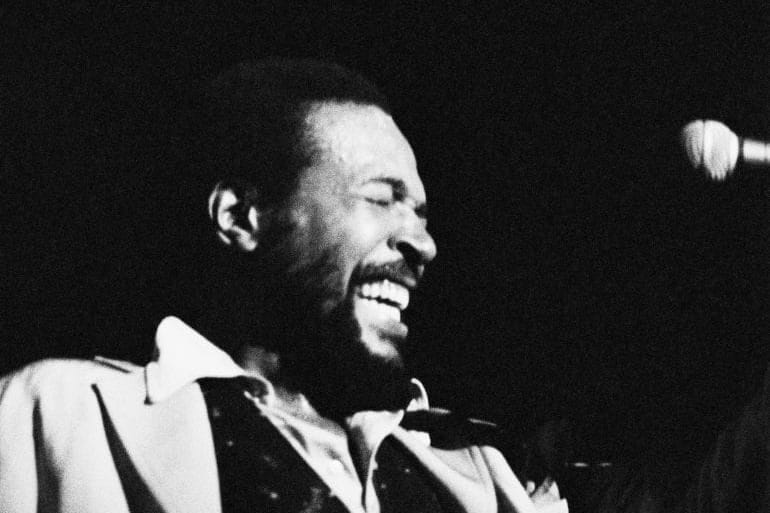For most of the 1960s Marvin Gaye was the crown prince of the Motown label. Blessed with Hollywood good looks and one of the greatest voices that pop music had ever witnessed, Gaye seemed poised to have the kind of cross-over success that was once promised for the likes of Nat King Cole and Sam Cooke. But right on the cusp of such success — Gaye’s recording “I Heard Through the Grapevine” was Motown’s best-selling single ever at the time of its release in 1968 — Gaye shifted his musical vision to give voice to impoverished Black urban communities, the destruction of the environment and the rising dissent against American involvement in the Vietnam War.
What’s Going On (1971), a recording that was at the center of a generation of artists seeking to speak “truth to power” after the death of Martin Luther King, Jr. and during sustained State repression of the Black protest movement. With What’s Going On Gaye joined artists like Freda Payne (“Bring the Boys Home”), Nina Simone (“Young, Gifted and Black” & “Mississippi Goddamn”), Eugene McDaniels (Headless Heroes of the Apocalypse), Edwin Starr (“War”) and John Lee Hooker (“I Don’t Want to Go to Vietnam”) contributing to a long tradition of Black social protest in music.
Just as quickly as Gaye transformed himself into a protest poet, he shifted again, making himself into the quintessential “love man” with Let’s Get It On (1973). For all intents Gaye had traveled from “protest” to “climax” as so much of Let’s Get It On was about the spiritual and existential pursuit of sex. This would become a common theme for much of Gaye’s music for the rest of his life, though arguably Gaye’s ability to highlight the complex relationship between sexual desire and spirituality had political implications given the ways that both had been policed by Black religious doctrine.
By the end of the 1970s, Gaye largely retreated from the public eye, in large part due to a bitter divorce from Anna Gordy Gaye (duly documented on the recording Here, My Dear), troubles with the IRS (refusing to pay his taxes as another form of protest), and the emergence of artists like Teddy Pendergrass and Rick James to challenge his “love man” throne. Gaye found relief in exile in Ostend, Belgium, and it is there in the early 1980s that Gaye began to plot his comeback to the American music scene.
No longer recording with Motown, Gaye signed with CBS Records in 1982 and collaborated with Gordon Banks on the track “Sexual Healing” which trumpeted Gaye’s return to the top of the R&B and pop charts and earn the veteran soul singer his first Grammy Awards in 1983. It was in the context Gaye’s return to the limelight that he was asked to perform the National Anthem at the 1983 NBA All-Star Game at the Los Angeles Forum.
Like the “Stubborn Kind of Fella” that Gaye had embodied for much of his life, he came strolling on court to a drum beat that Banks had programmed only the day before. Reminiscent of the backbeat that was featured on “Sexual Healing” Gaye’s version of “The Star-Spangled Banner” elicited celebratory catcalls, and halfway through the song the audience of over 17,000 were tapping their feet and clapping their hands in affirmation. It could have been any ole Sunday at any church in Black America, but instead it was on national television, moments before the tip-off of the yearly showcase for a sport that was coming into mainstream as Earvin “Magic” Johnson, Larry Bird, Julius Erving, and soon Michael Jordan would become household names.
Often thought of as the “sacred” anthem of American patriotism, Francis Scott Key’s composition is rarely performed beyond the parameters intended by the composer. The song, which was granted national anthem status in 1931, has been emblematic of the American ideal of citizenship and belonging for over a century. Alternatively, for those who are denied full citizenship and any sense of belonging, the “The Star-Spangled Banner” is little more soundtrack of American exclusion and imperialism. As such when artists perform distinctly personal versions of the song it often represents both a sense of ownership and protest. Such was the case when guitarist Jose Feliciano performed a controversial rendition of the song prior to Game 5 of the 1968 World Series game at Detroit’s Tiger Stadium. Gaye ironically performed a standard version of the anthem before Game 4.
No doubt memories of Feliciano’s performance (Motown was based in Detroit in the late 1960s) resonated with Gaye when he stepped on to center court at the Los Angeles Forum that day. Arguably, Gaye’s performance—one of his last appearances on national television before his murder a year later—not only put an exclamation on two generations of Black social protest in music, but offered a glimpse into a future in which, the technological innovations of Black music producers would come to dominate the arena of American Pop music. As such Gaye’s performance also marked the beginnings of the National Basketball Association’s now forty-year embrace of Black popular culture.
This post originally appeared on Medium and is edited and republished with author's permission. Read more of Mark Anthony Neal's work on Medium.
